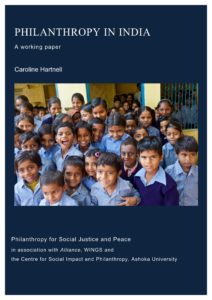by Amita Puri

In her fairly comprehensive paper, Philanthropy in India (a welcome addition to the literature on this topic), Caroline Hartnell emphasizes that the insights shared can only be a starting point in setting out an overview of philanthropy in India. For me the invitation to others to build on this is exciting in terms of the potential to add to the richness of the document, and to incorporate myriad voices beyond those represented. In this post, I will share some of the elements that I think can be added, need reflecting on, or raise further questions.
The contribution of the Indian diaspora
Apart from all the old and new forms of philanthropy mentioned in the report, the Indian diaspora has contributed significantly both in promoting development and in providing emergency assistance in the country. According to a survey carried out by the UN Department of Economic and Social Affairs, India’s diaspora population (those who were born in India but now live outside the country) is the largest in the world at 16 million in 2015. If the number of PIOs (persons of Indian origin) is added, the number is likely to more than double. UK/USA, UAE and Singapore form the hub of the Indian diaspora and have more than a quarter of all Indian diaspora members.
Giving back through family and friends for local religious and development projects has long been prevalent but over the last three decades it has grown to incorporate giving to civil society organizations with broader missions and evidence of impact. Both the rise in the volume of giving and the expanded nature of support have been facilitated by the rise of foundations and philanthropic intermediaries. Occupational, ethnic and regional support groups based overseas have also assisted in channelling the giving. The giving happens not only at an individual level but also via companies set up by Indians largely in the technology and financial space. The latter are quite active in the impact investing space.
The growth of volunteerism
Volunteerism as a form of philanthropic practice has traditionally existed in the religious arena but it is seeing substantial growth in the organized philanthropy space as well. India’s erstwhile Joy of Giving week, now Daan Utsav, celebrates all forms of giving. Most organizations have always welcomed volunteers. However, there now exist models that channel this exclusively for social development – largely fuelled by young people’s aspirations to get engaged and companies’ desire to engage and develop employees. These assets of education, expertise and positions of influence all have the potential to be applied to great effect.
Unchartered territory/unrepresented voices
As the paper mentions, India is a vast and complex country. However, most of our perspectives on the nature of Indian philanthropy and its practices are informed by what happens in the top ten urban centres of India. Apart from the flow of funds from intermediaries based in Tier 1 cities to organizations based in smaller towns and rural areas – our own version of global north and south – what other models, forms and practices prevail in these regions? There is definite merit in exploring this further.
How do we support and build philanthropy’s role as an agent of social change?
I think, however, that this is the most critical question that this paper raises. I believe two things will aid development of philanthropy’s role as an agent of social change:
- The creation of learning platforms. The paper touches on Dasra’s role in supporting philanthropists in their journeys; this is a definite gap area. Not only do more platforms for learning, exchange and collaboration need to be created, but the platforms need to engage people beyond just the very rich. Pravah’s model whereby young students learn not only how to make a difference but beyond that how to participate in civic life to build the common good is something that can be replicated in multiple ways and segments.
- Self-reflection by the sector on its own practices. This would also help in promoting philanthropy for social change. Much of the philanthropic sector depends on the rich and powerful and therefore in some ways perpetuates the very status quo it seeks to change. Further, its fundraising practices – the emphasis on and deference towards major donors and companies; the ‘donation at any cost’ approach to raising funds from retail donors; and the lack of effort to establish real contact and trust with partners – all tend towards the creation of short-term relationships that benefit no one, and obviate the very purpose for which philanthropy exists – creating a more just and humane society.
Amita Puri has been a part of the development sector for two decades and currently works as a consultant.